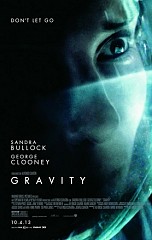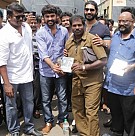PHOTOS & STILLS - GALLERY

THOUGHTS FROM MY STRATOSPHERE
After a busy fortnight of Navrathri that comes with the customary visit to friends, relatives and collecting sundals, vethalaipaakku and give-aways, I caught up with a couple of movies over the weekend (as if the whole exercise burned so much of my energy and called for a movie break). The film that sucked me deep into it right from the word Go was the much-raved film,‘Gravity’ directed by Alfonso Cuarón (not sure how to pronounce his surname though). I identify him as the director who gave us the third installment of ‘Harry Potter and the Prisoner of Azkaban’ besides 'Children of Men’. True to the simple definition of gravity being a natural phenomenon by which all physical bodies attract each other, here I was sitting at the cinema hall with my 3D glasses on, completely immersed and attracted to the astronomical idea and execution of the film. Much has been reviewed, acclaimed, rated and discussed about the film and therefore I’m not going to bother dissecting it scene by scene,analyzing the lead actors’ stellar performance and adding to the list of one more person having a point of view on it.
When you watch a movie and leave the cinema hall with a thought that lingers onto your mind days after you’ve seen it, that really is the effect of experiencing good cinema. When you want the world to see it and highly recommend it through word-of-mouth and social networking sites, that really is your way of supporting quality cinema. And when you go beyond just talking and act upon the embedded message of the film that has impacted you, that really elevates cinema to another stratosphere of bringing about some positive change in some corner of the world. ‘Gravity’ is a film that’s meant for a much larger purpose of bringing about that realization in each and every one of us that take the planet we inhabit so much for granted.
After a space mission gone horribly awry with no one to help out there and the very first time after 90 minutes of struggling at the galaxy, seeing a shot of the pristine water and land with birds flying in the sky somewhat pulls a trigger in you to pause and reflect what we have. The fresh oxygen that we breathe, the soft sand that we rest on, the clear water that we consume, the diverse flora and fauna that we’re accompanied with, the pet animal we come back home to, the piping hot food we feast ourselves with and the many pleasures of fine living make us a privileged lot. We’re born as human beings with the entitlement to experience the beautiful life and expected to leave the world behind in a condition that is conducive for others who come after us to live the way we lived. But we’re so caught up in our own world of quagmires and illusions that we fail to stop by and smell the air after a rain shower or appreciate the preservation of nature and the world around us.
In one of those introspective modes that we sometimes get into, I couldn’t help wondering what we would do if we were just floating in the air with no grip to go by our daily lives without the life-stabilizing interaction as gravity? What if there was no gravity to keep the planetsin their orbits around the sun, the moon in its orbit around the earth, the stars in its orbit of galaxies and the entire clusters in the universe intact? What if we couldn’t even cry with our tears rolling down our cheeks but droplets floating around us or any other liquid emitted out of us for that matter? Unfathomable, dreadful, sordid or however it may seem / differ for each one of us, the fact remains that we have a survivable place to relishour lives and most of the times, we don’t value the basic luxuries well enough to be socially answerable or morally liable.
Not intended to give any more ‘fundas’ on conservation or sustainability or risk being mocked as the only lone survivor who feels responsible for saving the eventual apocalypse, there’s just one message that I’m leaving behind from my interpretation of the inherent message in ‘Gravity’. We have to respect our resources, embrace the bountiful earth we live in and give a lot more than we already are taking from here, from life, from this planet. Everything else will fall in place, with or without gravity. In three words to ensure the survival of the planet and all living species, like the poster of the film claims, ‘Don’t Let Go’.
As for more interesting bits about the film itself, here’s a compilation of some trivia generously taken off the net for your reading. Chances are the ardent film buff has already had the time to browse through it. But for those who haven’t yet, here you go.
Gravitational Trivia
- Sandra Bullock spent six months in physical training to prepare for shooting while reviewing the script with Cuarón in meticulous detail.
- While filming the underwater scene, Cuarón held his breath along with Sandra Bullock to make sure he wasn't asking too much of her - he soon found he couldn't match her lung power.
- Though the film itself is scientifically accurate in depicting no sound in space, sound effects were added to the film's trailers to make them appear more exciting.
- Natalie Portman was the top choice for the lead role after Angelina Jolie twice refused it. Robert Downey Jr. was cast for the male lead but dropped out due to scheduling conflicts.
- The spacesuit that Dr. Stone puts on in the Russian Soyuz capsule has the number 42 on the patch. In the novel "The Hitchhiker's Guide to the Galaxy" 42 is the "Answer to the Ultimate Question of Life, The Universe, and Everything".
- The film's space debris cascade is a very real possibility. This scenario is known as the Kessler syndrome, named after NASA scientist Donald J. Kessler who first proposed the theory in 1978. A cascading Kessler syndrome involving an object the size of the International Space Station would trigger a catastrophic debris chain-reaction. The orbiting debris field would make it impossible to launch space exploration missions or satellites for many decades.
- A long-held rumor exists that NASA provides suicide pills to astronauts for worst-case scenarios (as depicted in the film ‘Contact’). NASA has denied this for decades, some stating that it would be easier and more comfortable to reduce oxygen in the chamber, as depicted in this film.
From space, the sun is white, not yellow as shown in the film. The reason it appears yellow on earth is because the atmosphere scatters the blue light from the sun (why the sky is blue), and allows the reds, yellows, and whites to come through giving it a generally yellow color. In space, there is no scattering of the blue light so the sun appears white.
Behindwoods is not responsible for the views of columnists.
FACEBOOK COMMENTS
OTHER LATEST COLUMNS
ANUJA IYER'S OTHER COLUMNS
- Thoughts from my Stratosphere
- Much in touch
- Tripped and rupeed
- Unfinished homework
- Like ah, No like ah?
- Classical touch
- An untimely frost
- 6 seconds to sway
- 100 and not out
- Galatta Kalyaanam
- Connections and conversations
- An hour with Haasan
- Eulogy
- Does age matter?
- Any Votes for devotion?
- The whole six yards
- Rejuvenating Revathy
- Madras Nalla Madras
- Audience beware
- Smile OK Please.
- Changing with the times
- Staging Live
- Lateral Triangle
- How to name it
- A magical morning
- Chromosome XX
- The difficulty of being good
- Whats In A Day
- Why this Pogaveri?
RELATED LINKS
- Much in touch
- Tripped and rupeed
- Unfinished homework
- Like ah, No like ah?
- Classical touch
- 6 seconds to sway
- 100 and not out
- Galatta Kalyaanam
- Senza Spa Saloon Launch - Videos
- Connections and conversations
- An hour with Haasan
- Eulogy
- Does age matter?
- Does age matter? I II
- Anuja Iyer unveils Ultralite Fusion Silk











